A portfolio of emotions
How not banishing but rather befriending all of them is the way to walk through everything.
I’m just back from spending time with a small group of teenagers who are unable to attend school and are, instead, being supported by a nearby youth organisation. I’ve unloaded all the photography gubbins that I took along with me from the car and have come outside to stand in the garden for a moment to regulate and reflect because I spoke aloud some words I hadn’t planned to say.
A heron has just coasted across the open sky beyond the back fence, wafting with grace and ease and heading left towards the bounty of the lake a quarter mile along the road from here. All trailing, spindly legs and delicate feathered fluidity in flow state. I cannot imagine the heron ever feeling anxiety in this elegant, lithe, sky borne body.
I was asked along to speak about portfolios and how to build one on the basis that I work as a photographer and have to create, update and share portfolios of my own work periodically.
As it turns out, I was able to help the group and quite a lot only not necessarily in the way either they or I had anticipated beforehand. I’ve never had to submit an actual printed portfolio of a body of work before. Have never once carried the big, black zipped portfolio case to pitch for a job, so today didn’t have a physical case of prints to showcase to them when we met in person.
All of my portfolios have been digitally created and shared over email. Hence, seated together in a circle of chairs just now, within a sun-kissed outside courtyard and without access to a big screen, I wasn’t able to showcase these virtual portfolios and so this part of our discussion was brief. Very brief. And this was the original brief. We were, though, able to get curious and play a little with all the sunlight and this delivered.
I almost wrote school avoidant teenagers just now, to describe these young people. A term I’ve certainly heard and am fairly sure is the descriptor used by educational settings for children who are unable to manage being in a school environment.
I rumbled for a second though with these words and decided they don’t sit at all well with me. Whilst I’ve no lived experience of this situation in parenting my own children, I’m here now thinking aren’t these words school avoidant a bit dismissively abrupt and catch-all? Shining a focus on the wrong thing? I have a real sense there’s an inference implied within this simplistic phrase (and some negative connotations?) that to not go to school is in some way a conscious choice. Anyway, I’ll come back to that.
Magnolia is tumbling over from next door’s garden. Great velvety, pink-tinged petals are dropping like giant’s confetti. They’re all quietly landing on fresh mole hill humps which, overnight, have bulged up from the bushy, clumpy, long and unkempt lawn like heaps of crumbled Bourbon biscuits for a cheesecake base.
This is a new view, this garden. We’re only four Saturdays settled in this home. And I mean settled in the very loosest crumbliest sense. I had an outbreak of shingles throughout the packing up of boxes and scouring the old house top to bottom. Not ideal. And the removals firm arrived a day early if you can imagine the horror of that scenario.
I definitely haven’t baked a cheesecake in this oven here, that’s for sure. Baked anything in fact. Ok, a pizza. I’ve also not made it out into this garden to prioritise the grass and it’s already towering.
The house is a comfortable 3-bed semi set back from the road and bordered either side by gardens with extremely tidy borders, outdoor sofas, spotlights that illuminate the pathway at night, bbqs, the whole garden space shebang. The neighbours have each been out jet washing their patios and decking this week in unseasonably elevated temperatures and sunshine. And I’m noticing a whiff of shame about the state of ‘our’ lawn; shame is rising up inside me and almost as high as the actual grass has grown. But enough about lawns.
So where was I and why? Well, with a small group of adolescents, all of them in Yr11 which is the final year of secondary school. They’re currently being supported by a local charity whilst out of school and several are considering taking art & design courses at college which they’re aiming to be in a position to attend after the summer. That’s why I was asked to join them today, to share what I know about making a portfolio of artistic work which is what they’ll need to submit for their application as their educational pathway has been a different one to the mainstream school norm. An unschooled pathway.
We chatted a while about the online app I use to prepare proposals when I’m pitching to a prospective client. It’s called Canva and is a brilliant and flexible tool with heaps of functionality (no affiliation btw) and which, if you do any design work here on your Substack, you too might find useful to create graphics and interesting pictures to embellish and illustrate your writing.

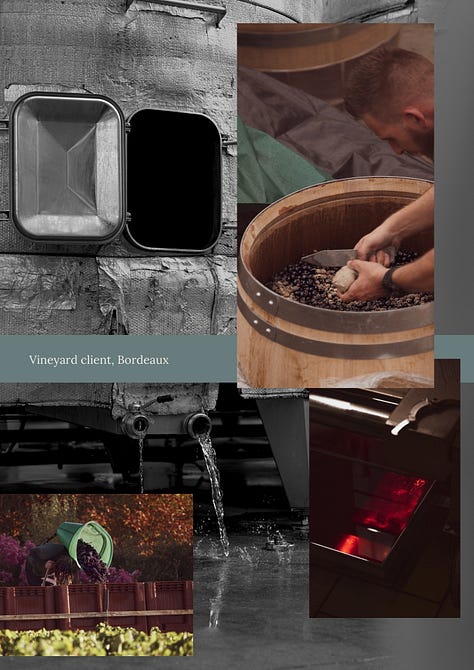
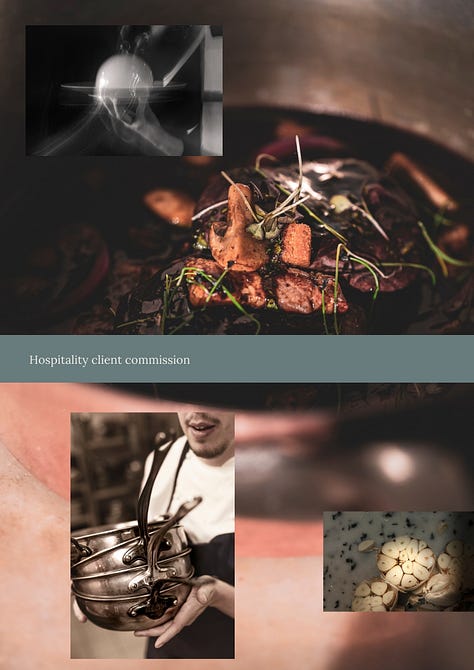
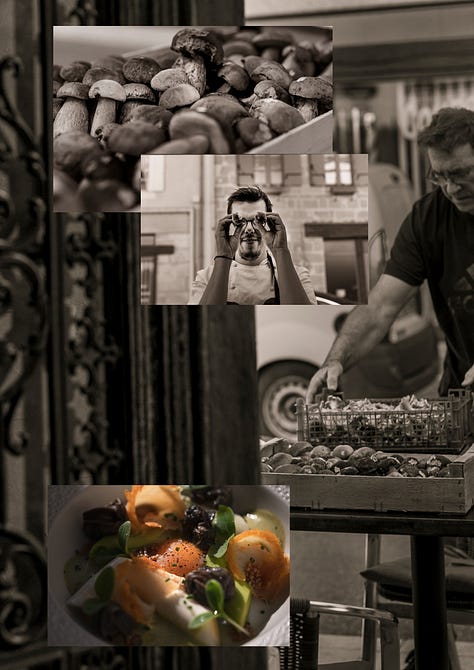


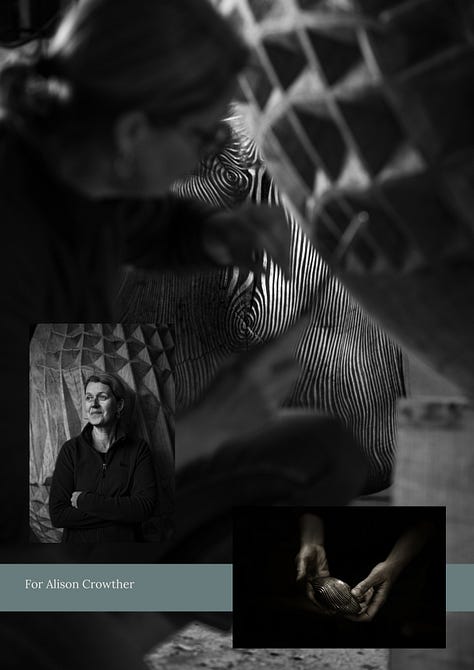


To demonstrate this, here is a mash-up portfolio featuring some of my recent restaurant, vineyard and artist work. I’ve added a few pages of this above. My income is generated from a mixture of client commissions - headshots amongst them but plenty else besides - teaching 1:1s and groups and after-school clubs. I also write copy and run a couple of client social channels. In case it may be of interest to you here is my website.
In our session, we also had a play with our phone cameras which I wasn’t sure we’d do but the light falling into the courtyard was exquisite and it felt like a timely ice breaker activity.
We talked about light, glanced around, observed and looked for and found the available daylight in the yard space. We learnt how to meter the light entering our phone cameras by tapping our fingers on the screen in various places and moving the yellow slider up and down. And to autofocus lock the camera to keep the lighting consistent.
We also switched to black and white mode. If you’re interested in improving your own phone photography, this is a gem of a top tip, so make a note to try this yourself. Having the screen show only black and white and no colour removes all the distraction that the colours bring. A monochrome view will show clearly where either too much light is falling or not quite enough light is falling in the frame and, therefore, which part of the picture is becoming illuminated as a result.
Without the distraction of colour, the light reveals the picture being made. This also is what photography means. The Greek root words for photography are photos (φῶς, light) and graphos (γράφω, to draw or write) which combine to mean drawing with light.
We popped open a few giant silver and white reflectors to turn take and bounce the rays around and onto one another’s faces. These are made of light cloth on a pop-out frame, 2-3 metres in diameter and powerful on a cloudless day such as this. The reflectors prompted quite a lot of laughter, some initial embarrassment, bursts of self-consciousness and a fair amount of squinting, wincing and bonding as we each accidentally blinded one another getting to grips with the physics of the situation.
What became clear and quickly was that the pictures improved a good deal when we used each of these strategies and also combined them. By metering the light with the easy-to-use slider on the phone screen, turning on the autofocus lock, positioning the subject with the sun behind them and using the reflectors to bounce light back into the shadows, switching to b&w mode, these prompts all enhanced our pictures and by quite a lot.
With teenagers and phone cameras, the biggest challenge I often encounter in workshops is to get them to pause. To slow right down and to think for a moment about the picture they’re about to make. To consider what they want to make the camera communicate for them and to cleave a space in between the thinking and the doing.
The majority of teenagers in the UK now own a smartphone. This itself is a terrifying statistic in its own right and one which I have strong views about to save for another day, but since these toxically addictive, distracting and disconnective devices are at their fingertips on a daily almost permanent basis - with some admitting and alarmingly to being constantly online - if I can even in the smallest, tiniest way make this a more creative experience for them that is at least something.
What always slightly surprises me is how rapid fire they can be and unaware of the very fundamental functions of the phone camera which they literally are using all the time.
And today, I surprised myself too actually. By speaking with radical honesty with these young people for whom anxiety is showing up as an obstacle. Speaking about how this last decade of work as a photographer has been infused with and coloured throughout by an accompaniment of anxiety rather than an absence of it. And sometimes enormous anxiety, not simply a tiny tremor of gently fluttering nerves, but more a bone-shaking, word-swallowing, jaw-clenching hot mess of the stuff.
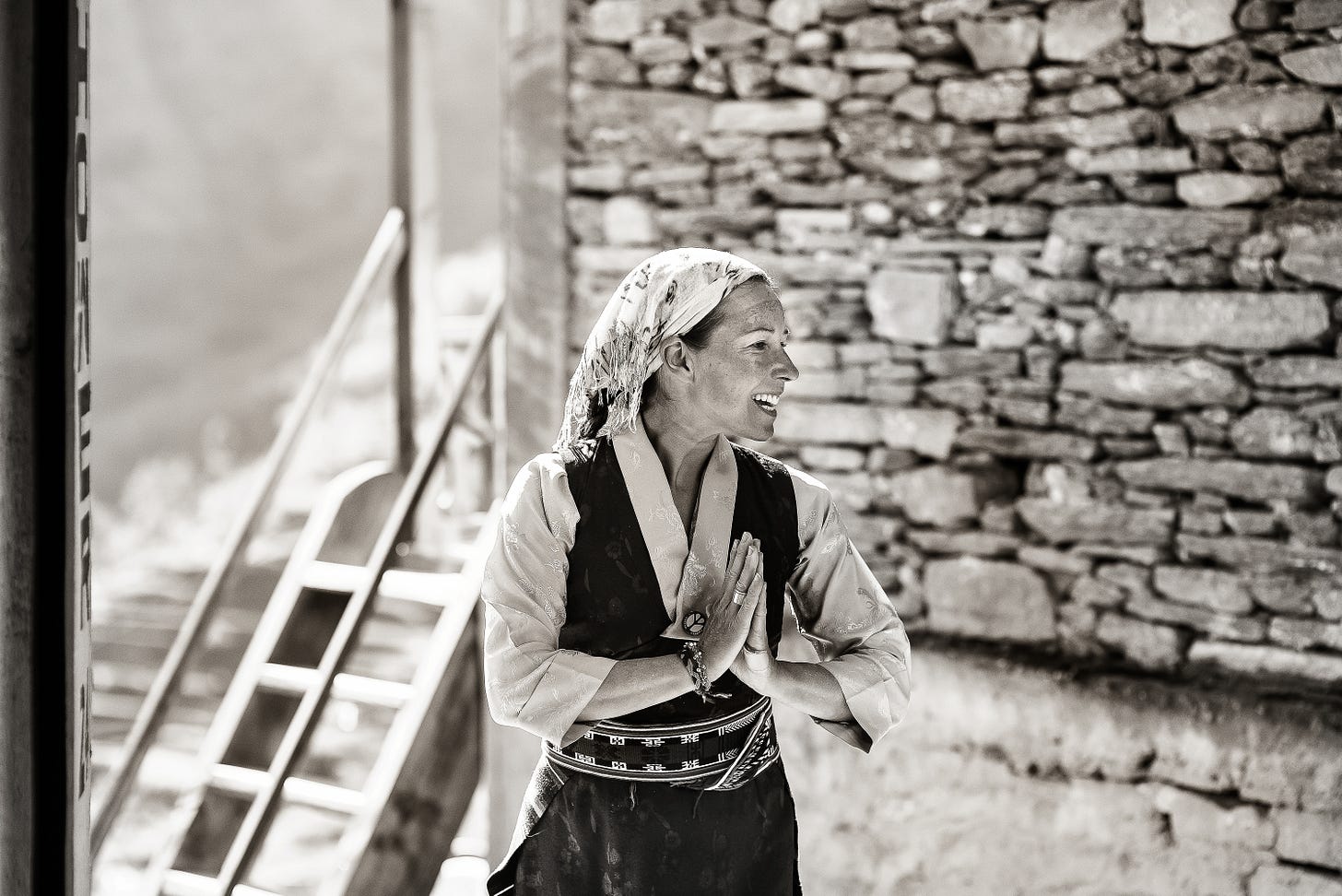
Especially at the beginning. Moments where fear flooded me, paralysed me even. Occasions where enormous, big emotions came up and where there was simply no time to process them so the pictures then became portals for some enquiry later.
I brought along and showed them framed prints from a trip to Nepal ten years ago which was really the one, single pivotal moment that prompted all of this photography. A giant and for me radical journey that meant leaving four children properly behind for the very first time and for an extended period. I cried my way through the flight watching emotionally charged films like Wild and The Theory of Everything then landed at Kathmandu airport and spent every moment in Nepal entirely and absolutely present coming home three weeks later, my mind and soul expanded and changed for ever by the experience.
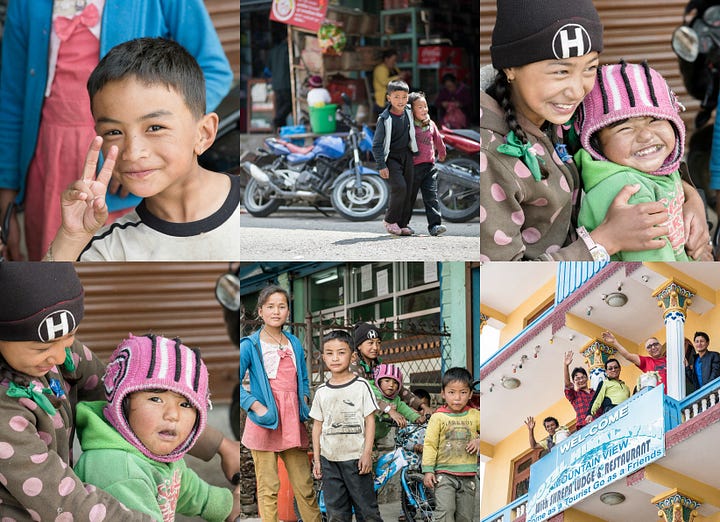

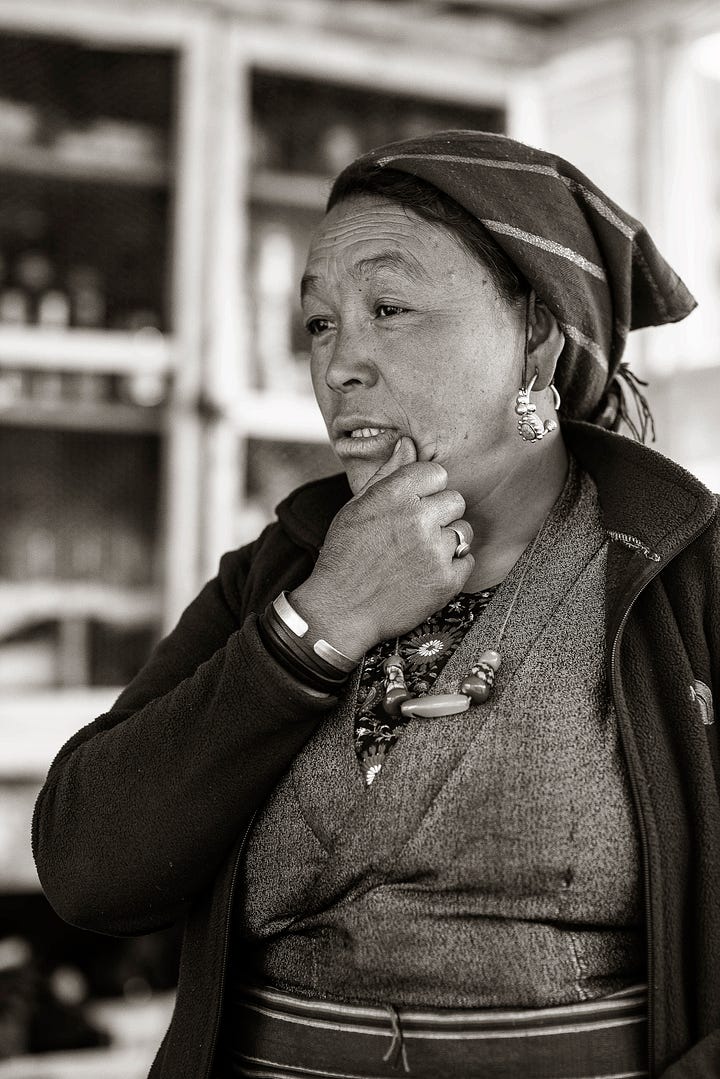
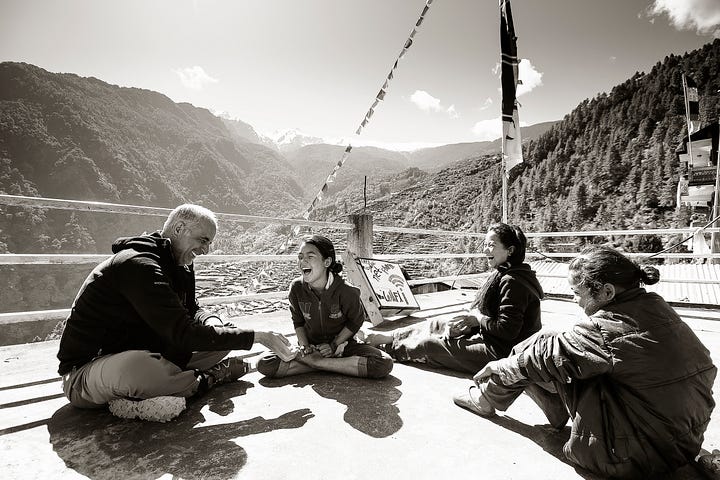
I remember one very early photoshoot in a farmyard space and with six or seven makers and their art to photograph, and I had my son with me. He has Down Syndrome, I had no childcare and he was very young and quite unruly and I was simultaneously having to direct the portraits and also with one eye trying to keep him safe. Half watching him roam around the place silently, in amongst the sharp and dangerous agricultural equipment, the deep pond and the mainline railway track that menaced from the perimeter. And all the while feeling largely incompetent and chaotic. Both behind the lens, in my circumstances and in steering my life in any coherent direction.
Times I said yes when I believed I wasn’t ready to cope with a project. The first wedding, sheesh, that was a thing. Times I used the camera as a shield to protect a fragile self and hide behind the black of it, creating space between my eyes and the reality of the scene. Times I totally messed up, broke kit, gashed the picture and learnt a valuable lesson in the usually excruciatingly painful process. I can see in hindsight that the anxiety was, in all of those moments, serving a really important purpose. The jittery heart, wide and wary eyes and runaway mouth were all there to show me something.
“Anxiety as a mechanism comes with a really strong promise of keeping us safe and preventing harm. It’s almost a protector part that is very organised and strategic which we need to befriend”
If you want to listen to two lovely lilting voices talking about precisely this above, Owen O’Kane in discussion with Julia Samuel here is a particularly good start point. They talk together about how anxiety absolutely does need to come along for the ride. Owen says at one point during the conversation, that unless we re-educate our anxiety it will come back over and over again. I’m nodding in acknowledgement here as I type! We just need to convince it to stand down so we can get on with what we need to do.
When I listened to this recently, it made me think about how I will sometime talk about the butterflies in my son’s stomach when he is feeling nervous. He imagines them all in there fluttering around and I’ll ask him, are they mostly nervous butterflies or are there some excited butterflies too? And we’ll carry on and then check back in later to see if there’s been a change, a metaphorical metamorphosis of sorts! And for him, this visualisation works. And so when I hear Owen state to
that anxiety is chemically very similar to excitement, this too resonates.Outside in the sunshine of the yard today, this felt a really super and connective experience. To me at least. I can’t of course speak for the young people present. They will certainly have experienced the situation entirely differently from me.
Maybe they’ll have heard some of my words. I heard words I hadn’t planned on saying. Words which communicated very clearly that anxiety and fear have often been present and very viscerally so. And saying these words aloud in this setting was cathartic and revelatory and brought me back into that person who felt all the terror and was often, very often, drenched in imposter syndrome.
I hope I left them with an understanding to trust themselves. To be curious and photograph what they’re drawn towards. To let go of the rope and trust their inner compass to direct them. This will lead to good places, to perhaps deeper interrogation and perhaps even more delicious curiosity.
This has taken me an absolute age to write. I’m not fast. I tumbled into a flow state in the process and now the day has almost disappeared. I might just about have time to actually mow the grass if I’m quick about it.





My word. Your writing! I have to go back and devour it all again with a fresh day and a new cup of tea. Truly magnificent.
This is so interesting, insightful and humane. The school avoidance thing and its obvious intersection with the rise of smartphones — but also your interest in drawing attention to the creative possibilities of these devices rather than demonising seems hopeful to me.